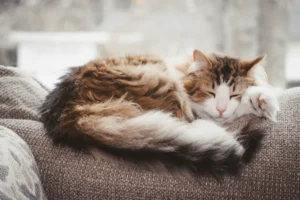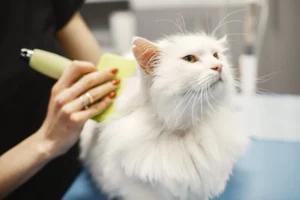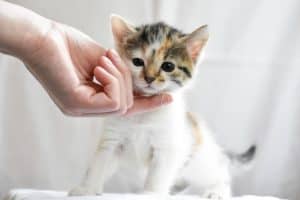Is your furry friend leaving a trail of flakes behind every time he takes a cat nap? Don’t fret, we’ve got the answers to why your cat is flaky when he sleeps.
If you’ve ever wondered why your cat sheds flakes while catching some Z’s, the answer may lie in a combination of factors such as dry skin, grooming habits, and environmental conditions. Let’s explore the reasons behind this common feline phenomenon.
Understanding Flaky Cat Skin
If you’ve ever wondered why your cat is flaky when they sleep, understanding the reasons behind their dry, flaky skin is key. Flakiness in cats can often be attributed to a lack of moisture in their skin, leading to issues like dandruff and discomfort. Just like humans, cats can experience dry skin due to various factors such as environmental conditions, diet, or underlying health issues.
One common reason for flaky skin in cats is a lack of essential fatty acids in their diet. Fatty acids play a crucial role in maintaining healthy skin and a shiny coat. If your cat’s diet is lacking in these nutrients, their skin may become dry and prone to flakiness. Ensure that your feline friend is receiving a balanced diet rich in omega-3 and omega-6 fatty acids to support their skin health.
Additionally, environmental factors like low humidity levels in your home can also contribute to your cat’s flaky skin. During the winter months when the air is dry, your cat’s skin may lose moisture, resulting in flakes. Consider using a humidifier to add moisture to the air, providing relief for your cat’s dry skin.
Regular grooming can also play a significant role in preventing flakiness in cats. Regular brushing helps to distribute natural oils throughout your cat’s coat, keeping their skin moisturized and healthy. If your cat has a tendency to groom excessively, it can strip their skin of essential oils, leading to dryness and flakiness. Monitoring their grooming habits and providing them with regular grooming sessions can help maintain their skin health and reduce flakiness.
Understanding the root cause of your cat’s flaky skin is essential in addressing the issue and ensuring their overall well-being. By providing proper nutrition, maintaining a healthy environment, and promoting regular grooming habits, you can help alleviate your cat’s flakiness and keep their skin healthy and comfortable.
For further information about cat skin health, you can visit the American Association of Feline Practitioners’ website for helpful resources and tips on keeping your feline friend’s skin in top shape.
Let’s move on to the next section to explore how your cat’s grooming habits can impact the appearance of flakes during sleep and what you can do to help.
Grooming Habits and Flakiness
As your cat snoozes peacefully, you may notice flakes on their fur, leaving you wondering why they’re so flaky when they sleep. Your cat’s grooming habits play a significant role in the appearance of flakes during sleep. Cats are meticulous groomers and spend a large portion of their day cleaning themselves. However, excessive grooming or improper grooming techniques can lead to flaky skin.
When your cat overgrooms, they may strip their skin of essential oils, leading to dryness and flakiness. This excessive grooming behavior can be triggered by stress, boredom, or underlying skin conditions. Monitoring your cat’s grooming habits and providing them with a stress-free environment can help reduce the risk of flaky skin during sleep.
To help alleviate your cat’s flakiness, ensure they have access to clean and fresh water at all times. Proper hydration is essential for maintaining healthy skin and preventing dryness. Additionally, consider using a moisturizing shampoo specifically designed for cats with dry skin to help nourish their skin and reduce flakiness.
Regular grooming sessions can also help keep your cat’s skin healthy and flake-free. Brushing your cat’s fur helps to remove dead skin cells and distribute natural oils, promoting a shiny coat and healthy skin. Establishing a grooming routine and sticking to it can go a long way in preventing flakiness and maintaining your cat’s skin health.
By understanding your cat’s grooming habits and taking steps to promote proper grooming practices, you can help alleviate their flakiness and ensure they sleep comfortably without the presence of pesky flakes. Remember, a happy and healthy cat starts with good skin care habits.
So there you have it—insights into why your cat may be flaky when they sleep, and how you can help address this issue with proper grooming and care.
Environmental Factors Impacting Flakiness
Is your cat leaving a trail of flakes behind when they snooze? Environmental factors like humidity levels, temperature, and air quality could be playing a role in their flaky skin during sleep. High humidity can lead to excess moisture on your cat’s skin, potentially causing flakiness. On the other hand, dry air can strip away natural oils, leaving their skin dry and prone to flaking. Ensure your cat has a comfortable sleeping environment with appropriate temperature and humidity levels to minimize flakiness. Additionally, consider using a humidifier or air purifier to maintain optimal conditions for your feline friend’s skin health.
Tips for Managing Flakiness
You love your furry companion, and seeing them struggle with flaky skin during sleep can be tough. But fret not, as there are practical tips to help manage and reduce flakiness in your cat. Regular grooming sessions with a gentle brush can help remove dead skin cells and distribute natural oils, promoting healthier skin. Opt for cat-friendly shampoos and conditioners to keep their skin moisturized and free from flakes. Remember to provide a balanced diet rich in essential fatty acids to support their skin health from the inside out. And don’t forget to consult with your veterinarian for personalized advice on managing your cat’s flakiness effectively.
- Hydration is Key: Make sure your cat has access to fresh water at all times to support their skin hydration and overall health.
- Regular Vet Check-ups: Schedule regular visits to the vet to monitor your cat’s skin condition and address any underlying health issues contributing to flakiness.
- Quality Diet: Choose high-quality cat food that is tailored to support skin and coat health, containing essential nutrients like omega-3 fatty acids.
- Stress Management: Keep your cat stress-free as anxiety can exacerbate skin issues. Provide enriching activities and a peaceful environment for your feline friend to thrive.
- Supplements: Consider adding skin-supporting supplements like omega-3 fatty acids or fish oil to your cat’s diet under the guidance of your veterinarian.
By implementing these tips and creating a skin-friendly environment for your cat, you can help them say goodbye to flakiness during sleep and hello to blissful slumbers.
The Importance of Regular Vet Check-ups
Regular veterinary check-ups are crucial in maintaining your cat’s skin health. During these visits, the vet can assess your feline friend’s skin condition, identify any underlying issues causing flakiness, and recommend appropriate treatment. Skin problems in cats can range from allergies to parasites, and a vet can provide the necessary expertise to address these issues effectively. By scheduling routine check-ups, you can stay on top of your cat’s skin health and ensure they are comfortable and happy.
Fun Fact: Cats and their Flaky Skin
Did you know that a cat’s skin is thinner and more delicate than human skin? This unique feature makes cats more prone to dryness and flakiness, especially during sleep when their grooming routine may be disturbed. Additionally, cats have a higher concentration of sebaceous glands, which can sometimes produce excess oils, leading to skin issues like flakiness. Understanding these characteristics of feline skin can help explain why your cat experiences flakiness when they sleep. It’s essential to provide proper grooming and nutrition to support your cat’s skin health and prevent flakiness.
- Unique Insight:
- Cats groom themselves by licking their fur, which can sometimes lead to ingesting loose hairs. These hairs can form hairballs in their digestive system, causing discomfort and sometimes leading to vomiting. This grooming behavior can also impact the condition of their skin and contribute to flakiness. Consider providing a specialized diet or supplements to help reduce hairballs and support your cat’s skin health.
Remember, your cat’s skin health is essential for their overall well-being. By staying informed and proactive, you can ensure your feline companion stays flake-free and comfortable during their snooze sessions.
Bonus Tip: Creating a Skin-friendly Environment
Is your furry friend constantly dealing with flaky skin? One way to help alleviate this issue is by creating a skin-friendly environment for your cat. By taking a few simple steps, you can promote overall skin health and reduce flakiness.
First and foremost, make sure your cat’s living space is clean and free of any irritants that could be contributing to their flaky skin. Regularly cleaning their bedding, toys, and any other areas they frequent can help minimize exposure to potential allergens.
Additionally, consider investing in a high-quality humidifier to add moisture to the air. Dry environments can exacerbate skin issues, so increasing humidity levels can help keep your cat’s skin hydrated and healthy.
Furthermore, pay attention to your cat’s diet. Providing a balanced, nutritious diet that includes essential fatty acids can help improve skin health from the inside out. Omega-3 fatty acids, found in fish oil supplements or certain cat foods, are particularly beneficial for skin health.
Lastly, consider incorporating regular grooming sessions into your cat’s routine. Brushing your cat regularly can help remove dead skin cells and distribute natural oils, promoting a healthy coat and skin. Plus, grooming sessions provide the perfect opportunity to check for any skin abnormalities or signs of irritation.
By creating a skin-friendly environment for your cat, you can help reduce flakiness and support overall skin health. Your furry companion will thank you for the extra care and attention to their skin needs.
Additional Tip: Consider consulting with your veterinarian to rule out any underlying medical conditions that could be contributing to your cat’s flaky skin. A professional opinion can help guide you in creating the best skin-friendly environment for your feline friend.
Remember, a healthy environment and proper care are key to keeping your cat’s skin happy and flake-free.
Alex, a passionate animal lover, has experience in training and understanding animal behavior. As a proud pet parent to two dogs and three cats, he founded AnimalReport.net to share insights from animal experts and expand his knowledge of the animal kingdom.




